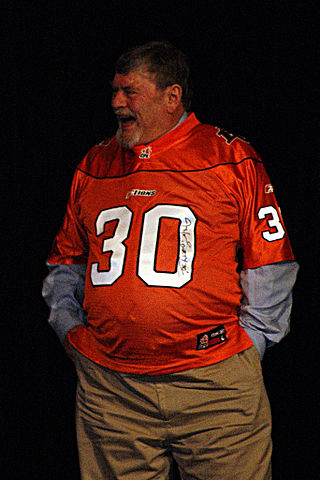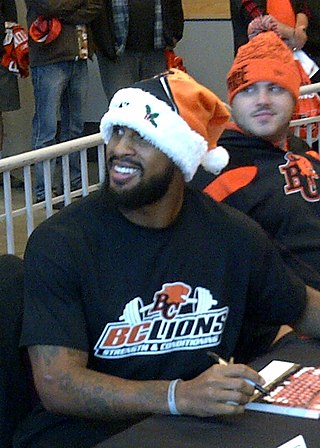Related Research Articles

Canadian football is a sport played in Canada in which two teams of 12 players each compete for territorial control of a field of play 110 yards (101 m) long and 65 yards (59 m) wide attempting to advance a pointed oval-shaped ball into the opposing team's scoring area.

In several forms of football, a forward pass is the throwing of the ball in the direction in which the offensive team is trying to move, towards the defensive team's goal line. The forward pass is one of the main distinctions between gridiron football in which the play is legal and widespread, and rugby football from which the North American games evolved, in which the play is illegal.

Gridiron football, also known as North American football, or in North America as simply football, is a family of football team sports primarily played in the United States and Canada. American football, which uses 11 players, is the form played in the United States and the best known form of gridiron football worldwide, while Canadian football, which uses 12 players, predominates in Canada. Other derivative varieties include arena football, flag football and amateur games such as touch and street football. Football is played at professional, collegiate, high school, semi-professional, and amateur levels.
This is a glossary of terms used in Canadian football. The Glossary of American football article also covers many terms that are also used in the Canadian version of the game.
- Legally positioned at the kick-off or the snap. On kick-offs, members of the kicking team must be behind the kick-off line; members of the receiving team must be at least 10 yards from the kick-off line. On scrimmages, at the snap the offence must be behind the line of scrimmage; the defence must be at least one yard beyond the line of scrimmage.
- A player of the kicking team who can legally recover the kick. The kicker and any teammates behind the ball at the time of the kick are onside. Thus on kick-offs all players of the kicking team are onside, but on other kicks usually only the kicker is. The holder on a place kick is not considered onside.
- A defensive position on scrimmages, also called free safety. Typical formations include a single safety, whose main duty is to cover wide receivers. See also defensive back.
- A two-point score. The defence scores a safety when the offence carries or passes the ball into its own goal area and then fails to run, pass, or kick the ball back into the field of play; when this term is used in this sense, it is also referred to as a safety touch.

American and Canadian football are gridiron codes of football that are very similar; both have their origins partly in rugby football, but some key differences exist between the two codes.
In American and Canadian gridiron football, pass interference (PI) is a foul that occurs when a player interferes with an eligible receiver's ability to make a fair attempt to catch a forward pass. Pass interference may include tripping, pushing, pulling, or cutting in front of the receiver, covering the receiver's face, or pulling on the receiver's hands or arms. It does not include catching or batting the ball before it reaches the receiver. Once the ball touches any defensive player or eligible offensive receiver, the above rules no longer apply and the defender may tackle the receiver or attempt to prevent them from gaining control of the ball. Once a forward pass is in the air it is a loose ball and thus any eligible receiver – all defensive players are eligible receivers – may try to catch it. When a defensive player catches a forward pass it is an interception and their team gains possession of the ball. Some actions that are defined as pass interference may be overlooked if the defender is attempting to catch or bat the ball rather than focusing on the receiver.

In gridiron football, a reception, also known informally as a catch, is part of a passing play in which a player in bounds successfully catches (receives) a forward pass thrown from a friendly quarterback behind the line of scrimmage. After making the catch, the receiver will then proceed to run towards the opposing end zone carrying the ball and try to score a touchdown, unless the play ends due to him being downed or forced out of bounds. Yardage gained from the passing play are credited to the catcher as his receiving yards.
Arthur Louis Powell was an American professional football player who was a wide receiver in the National Football League (NFL) and American Football League (AFL). He played college football for the San Jose State Spartans.

Slotback, sometimes referred to as an A-back or slot receiver, is a position in gridiron football. The "slot" is the area between the offensive tackle and the wide receiver. A player who lines up between those two players and behind the line of scrimmage fills that "slot".

James Norman Young is a former professional American football and Canadian football player. Young played running back and wide receiver for the NFL's Minnesota Vikings for two seasons (1965–66), and the CFL's BC Lions for thirteen seasons (1967–79). Young is a member of Canada's Sports Hall of Fame, the Canadian Football Hall of Fame, the BC Sports Hall of Fame, and the Queen's University Football Hall of Fame. Young's #30 jersey is one of ten numbers retired by the BC Lions. In 2003, Young was voted a member of the BC Lions All-Time Dream Team as part of the club’s 50th anniversary celebration. In 2006, Young was voted to the Honour Roll of the CFL's top 50 players of the league's modern era by Canadian sports network TSN.
Mervyn L. Fernandez, nicknamed "Swervin' Mervyn", is an American former professional football player who was a wide receiver with the BC Lions in the Canadian Football League (CFL) and Los Angeles Raiders in the National Football League (NFL).
Terry Greer is a former professional American and Canadian football player who played wide receiver with the Canadian Football League Toronto Argonauts and the NFL Cleveland Browns as well as the San Francisco 49ers. He held the CFL record for most catches in a season; he is a member of the Argonauts all-time team and his #10 has been honored by the team. Terry Greer was the first to gain 2,000 yards receiving in a professional football season.

In gridiron football, motion refers to the movement of an offensive player at the time of the snap.
The following terms are used in American football, both conventional and indoor. Some of these terms are also in use in Canadian football; for a list of terms unique to that code, see Glossary of Canadian football.

Emmanuel Arceneaux is an American professional wide receiver for the Edmonton Elks of the Canadian Football League (CFL). He played college football at Alcorn State University.

Darvin Adams is an American professional football wide receiver who is currently a free agent. Adams is a two-time CFL champion, winning the 107th Grey Cup and 108th Grey Cup by defeating the Hamilton Tiger-Cats in both games. He was signed by the Carolina Panthers as an undrafted free agent in 2011, Adams has also been a member of the Virginia Destroyers (UFL), Toronto Argonauts (CFL), and Ottawa Redblacks (CFL). He played college football at Auburn with whom he won the 2011 BCS National Championship.

Nathaniel "Nate" Behar is a professional Canadian football wide receiver for the Ottawa Redblacks of the Canadian Football League (CFL). He played for two years with the Edmonton Eskimos prior to becoming a free agent and signing with the Redblacks. He played U Sports football for the Carleton Ravens from 2013 to 2016.

Markeith Ambles is an American professional gridiron football wide receiver for the Toronto Argonauts of the Canadian Football League (CFL). He played college football at Houston. He has also been a member of the Calgary Stampeders.

Shai Ross is a professional Canadian football wide receiver for the BC Lions of the Canadian Football League (CFL).
Diondre Overton is an American football wide receiver for the Philadelphia Stars of the United States Football League (USFL). He played college football at Clemson and has also spent time with the Hamilton Tiger-Cats and Vienna Vikings.
References
- ↑ "NFL Football Glossary". The Washington Post . Retrieved January 17, 2009.
- ↑ "The Official Playing Rules for the Canadian Football League 2019". Canadian Football League. 2019. pp. 85–86. Retrieved October 20, 2021.